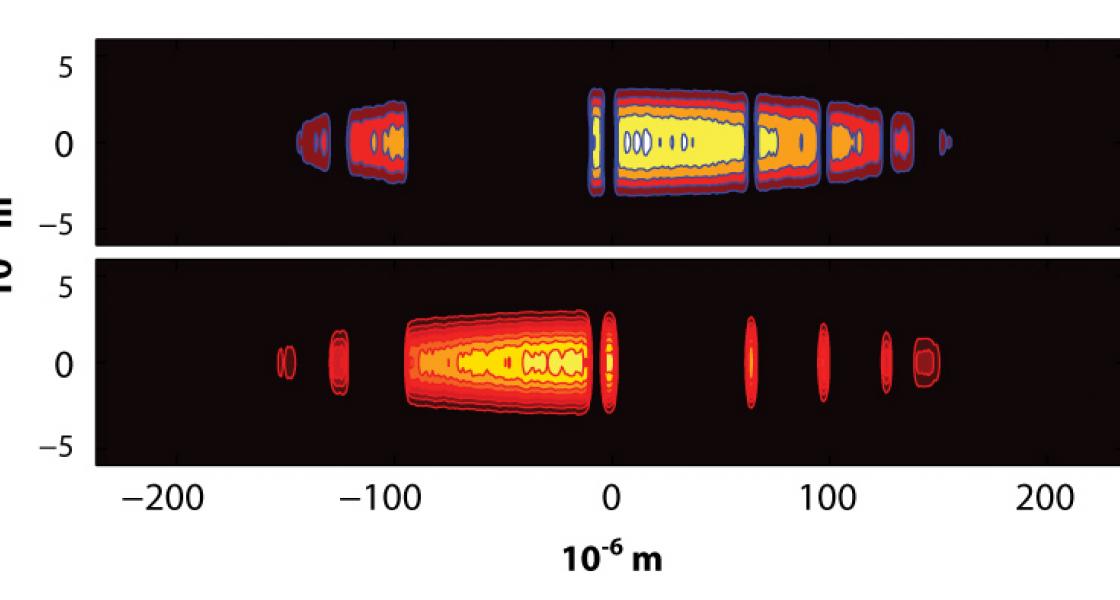A while back, former graduate student Scott Papp, graduate student Juan Pino, and Fellow Carl Wieman decided to see what would happen as they changed the magnetic field around a mixture of two different rubidium (Rb) isotopes during Bose-Einstein condensation. They assumed that the interactions between the atoms would change. They also expected they would observe two distinct condensates at some point. What they didn’t expect was the formation of alternating "bubbles" of 85Rb and 87Rb inside their cigar-shaped trap.
The interleaved condensates appeared when repulsive interactions between the 85Rb and 87Rb atoms dominated interactions between the same kinds of atoms. Under these conditions, 85Rb and 87Rb stopped happily being part of the ultracold atom gas mixture. Instead, they began to repel each other so strongly that they became immiscible like oil and water. As they grew increasingly incapable of being mixed, the condensate bubbles appeared. Pino said that watching the bubbles form was like seeing chunks of ice suddenly emerge in a pool of water.
The researchers were fairly sure that the bubbles were excited states and not the ground-state condensates they had anticipated. However, there was no theory available at the time to explain what they’d observed. However, now there is a theoretical explanation, thanks to research associate Shai Ronen, Fellow John Bohn, and their colleagues from Georgia Southern University.
Ronen and his colleagues were able to simulate the formation of the bubbles during evaporative cooling of a mixture of ultracold 85Rb and 87Rb atoms. They also verified that the ground state of a dual condensate of 85Rb and 87Rb would either be a mixed-atom condensate (under conditions where the atoms mixed well) or two spatially separated condensates, one consisting of 85Rb and the other consisting of 87Rb (under conditions where mixing could not occur).
The simulations showed that when condensates form in a rapidly cooled immiscible mixture of atoms in a cigar trap, they create multiple alternating bubbles of the different atoms. And, the bubbles are far from the system's true ground state. Even so, the bubble pattern is quite stable. The repulsive interactions between the different atoms are responsible for this behavior.
When a condensate first begins to form, the interactions between 85Rb and 87Rb atoms don’t affect the process much. The two species mix initially like water and milk. However, as the condensate grows and becomes denser, the repulsive interactions come into play. Eventually one type of atom, e.g., 85Rb, "wins" and pushes the condensed 87Rb atoms away from the middle. As the initial cloudlets (which are still partially mixed) continue to grow, they subdivide into more and more bubbles. The formation of new bubbles stops when each cloudlet is 100% either 85Rb or 87Rb. The components have become completely unmixed – like water and oil. The faster the mixture cools, the more bubbles form.
Although the newly formed bubbles of a given atom may 'wish' to merge together, the geometry of the trap prevents them from coalescing. For bubbles to merge, a cloudlet of 85Rb would need to "pass through" a cloudlet of 87Rb, but this is not possible because of the repulsion between them. The only way to get an immiscible mixture to form two ground-state condensates in a cigar trap would be to cool it very slowly, giving the 85Rb and 87Rb atoms enough time to condense on either end of the trap. - Julie Phillips



 The Physics Frontiers Centers (PFC) program supports university-based centers and institutes where the collective efforts of a larger group of individuals can enable transformational advances in the most promising research areas. The program is designed to foster major breakthroughs at the intellectual frontiers of physics by providing needed resources such as combinations of talents, skills, disciplines, and/or specialized infrastructure, not usually available to individual investigators or small groups, in an environment in which the collective efforts of the larger group can be shown to be seminal to promoting significant progress in the science and the education of students. PFCs also include creative, substantive activities aimed at enhancing education, broadening participation of traditionally underrepresented groups, and outreach to the scientific community and general public.
The Physics Frontiers Centers (PFC) program supports university-based centers and institutes where the collective efforts of a larger group of individuals can enable transformational advances in the most promising research areas. The program is designed to foster major breakthroughs at the intellectual frontiers of physics by providing needed resources such as combinations of talents, skills, disciplines, and/or specialized infrastructure, not usually available to individual investigators or small groups, in an environment in which the collective efforts of the larger group can be shown to be seminal to promoting significant progress in the science and the education of students. PFCs also include creative, substantive activities aimed at enhancing education, broadening participation of traditionally underrepresented groups, and outreach to the scientific community and general public.